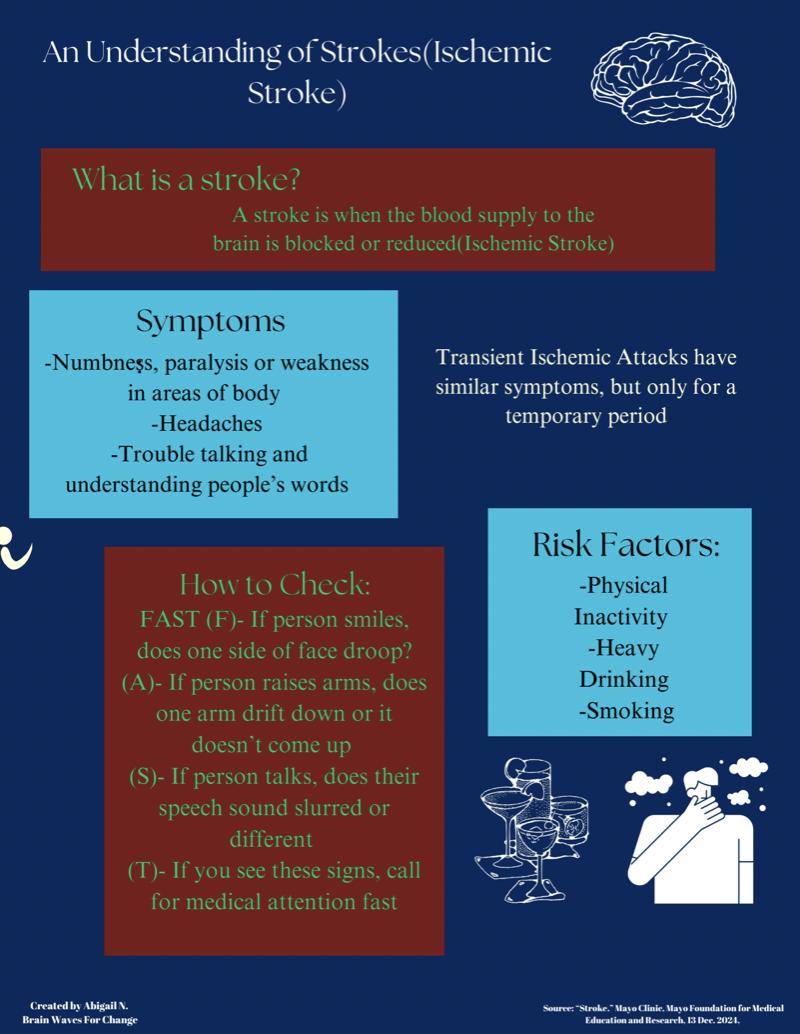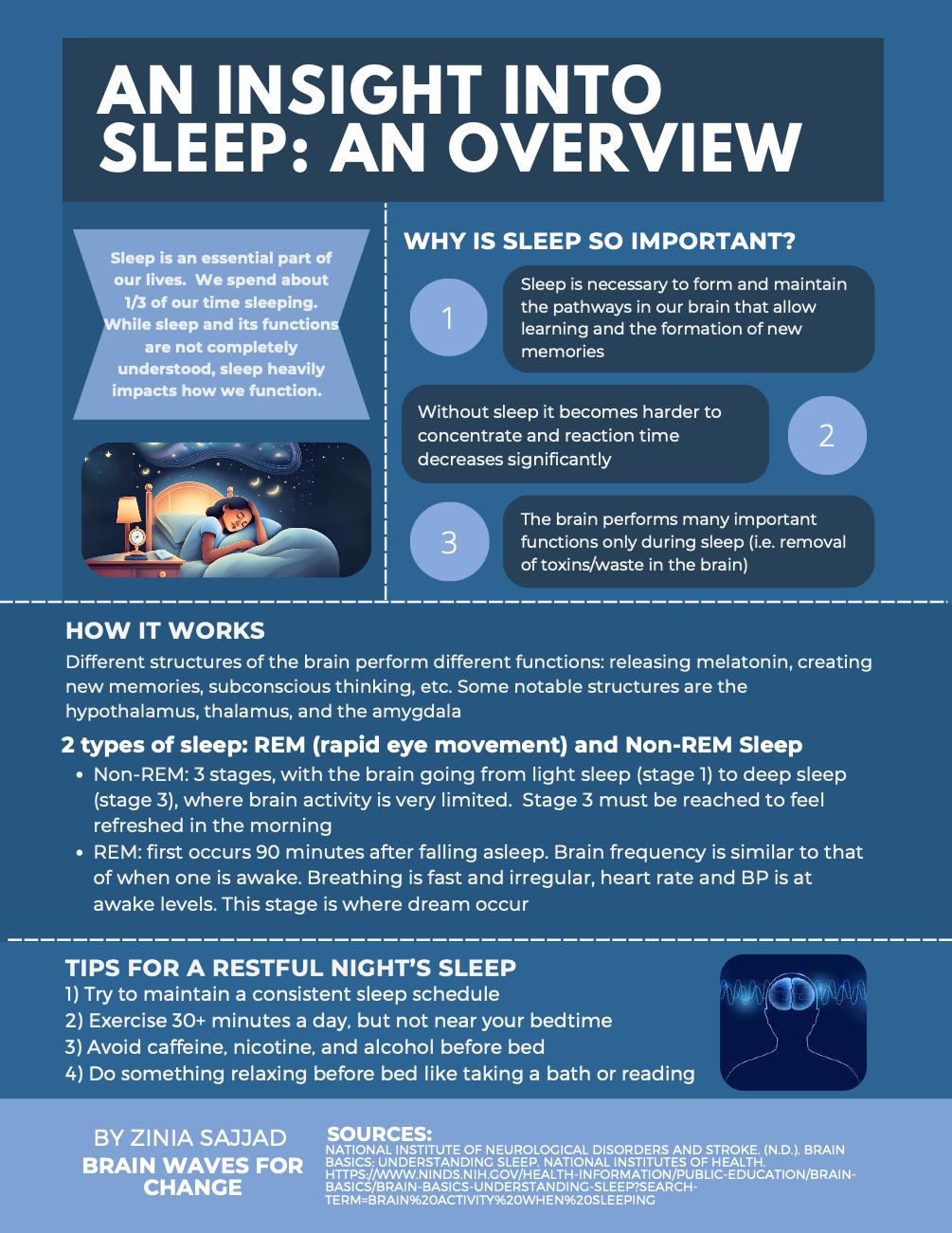

Brain Waves for Change
2025 Winter Wave Anthology
Brain Waves for Change (BWC) is a a fiscally sponsored 501(c)(3) nonprofit organization dedicated to providing accessible brain health education. Through arts & crafts children’s workshops, educational presentations, and community -wide fundraising, we spark a deeper understanding of neuroscience and mental wellbeing. Our youth-led team is at the core of our mission to inspire younger generations to stand up, speak out, and lead the conversation on brain health. Together, we aim to create a future where brain health is prioritized and education becomes the tool that saves lives. © 2024

Executive Board

PRODUCTION TEAM
Sonja Xie
Director
Adrian Wang
Head Editor
Sarah Kobi
Daisy Bennett
Clara Liu
Noah Ng
Ada Langford
Cover Art Clara Liu
Neurological Disorders & Conditions
Avantika Raj I Bell’s Palsy 007
Maddy Nam I Epilepsy 008
Maham Ali I Parkinson’s Disease 009
Abigail Sierra I Dementia 010
Sukhmeet Kaler I Multiple Sclerosis 011
Abby Nam I Strokes 012
Constance Huynh I Amyotrophic Lateral Sclerosis 013
Mental Health & Cognitive Disorders
Brain Function & Lifestyle
Understanding Bell’s palsy
What is bell’s palsy?
Bell’s palsy is a neurological condition that causes sudden weakness in the muscles on one side of the face, making half the face appear to droop.
Symptoms
Mild weakness to total paralysis on one side of the face.
Facial droop and drooling. Pain in the jaw or pain behind the ear on the affected side. Increased sensitivity to sound on the affected side. Headache and loss of taste.
Change in amount of tears and saliva produced.
Created by Avantika Raj Brain Waves for Change

Causes
The causes of Bell’s palsy are not fully understood, but, experts believe a cause is swelling and irritation of the nerve that controls one side of the face. This often occurs as a reaction after a viral infection. Bell’s palsy is common in pregnant women (2nd/3rd trimester/1 week after giving birth), in those who are diabetic, and in those who have obesity
Treatment
Most people with Bell’s Palsy eventually recover. Some treatment options are: Lubricating eye drops on the affected side. Corticosteroids (anti-inflammatory) such as Rayos and Prednisone Intensol.
Physical therapy
In the past, decompression surgery was used to relieve pressure on the facial nerve by opening the bony passage the bone passes through.
Sources
(“Bells Palsy Treatment in Gurgaon | Facial Stimulation Therapy,” n.d.)
(“Bell’s Palsy - Diagnosis and Treatment - Mayo Clinic,” n.d.)
(“Bell’s Palsy - Symptoms and Causes,” n.d.)
Epilepsy Awareness
Brain Waves for Change
Created by Maddy Nam




02
What is Epilepsy?
Epilepsy disrupts the continuous electrical impulse pattern that allows brain cells to communicate to the rest of your body, leaving bursts of electrical energy This leads to changes in your awareness and may affect your muscle movements, and possibly losing consciousness.
01
Signs/Symptoms:
Temporary confusion
“Staring out into space”
Stiff muscles
What To Do:
Convulsion: jerking of limbs
Loss of consciousness
Fear, anxiety, or deja vu.
Use a blanket/cushion to protect their head, do not restrain them. Remove any items that could injure them
Stay with them
Do not go near their mouth
Call 911 if the seizure is their first one, lasts longer than 5 minutes (time it), or injures them. After seizure, turn them on their side with their mouth pointing down.
Check for medical bracelet.
04




AMYOTROPHIC LATERAL SCLEROSIS: OUTLINE

Amyotrophic Lateral Sclerosis (ALS), also known as Lou Gehrig's disease, is a progressive neurodegenerative disorder that affects the nervous system, specifically the motor neurons responsible for voluntary muscle movement. The disease leads to gradual muscle weakness and loss of function, ultimately impacting a person’s ability to speak, swallow, move, and breathe.

TREATMENT AND MANAGEMENT
NO CURE: ALS IS CURRENTLY INCURABLE, BUT TREATMENTS CAN MANAGE SYMPTOMS AND IMPROVE QUALITY OF LIFE.
MEDICATIONS:
RILUZOLE: REDUCES MOTOR NEURON DAMAGE AND SLIGHTLY PROLONGS SURVIVAL.
EDARAVONE: MAY SLOW FUNCTIONAL DECLINE IN SOME PATIENTS SYMPTOM MANAGEMENT:
PHYSICAL THERAPY: MAINTAINS MOBILITY AND REDUCES SPASTICITY
SPEECH THERAPY: HELPS WITH COMMUNICATION.
NUTRITIONAL SUPPORT: PREVENTS
MALNUTRITION THROUGH DIETARY CHANGES OR FEEDING TUBES
RESPIRATORY CARE: MAY INCLUDE NONINVASIVE VENTILATION OR TRACHEOSTOMY
SUPPORTIVE CARE:
MULTIDISCIPLINARY TEAM APPROACH
CAUSES AND RISK FACTORS
SPORADIC ALS: THE MOST COMMON FORM (~90–95% OF CASES), WITH NO CLEAR GENETIC LINK.
FAMILIAL ALS: ACCOUNTS FOR 5–10% OF CASES, CAUSED BY INHERITED GENETIC MUTATIONS, SUCH AS IN THE SOD1 OR C9ORF72 GENES
RISK FACTORS:
AGE: MOST COMMONLY OCCURS BETWEEN 40 AND 70 YEARS
GENDER: SLIGHTLY MORE COMMON IN MEN, THOUGH THE GENDER
DISPARITY DIMINISHES WITH AGE ENVIRONMENTAL FACTORS: POSSIBLE LINKS TO EXPOSURE TO TOXINS, HEAVY METALS, OR REPETITIVE PHYSICAL TRAUMA, THOUGH NOT DEFINITIVELY PROVEN
SYMPTOMS
EARLY SYMPTOMS ARE SUBTLE AND MAY VARY, INCLUDING: MUSCLE WEAKNESS IN LIMBS (E.G., DIFFICULTY WALKING OR GRIPPING OBJECTS)
FASCICULATIONS (MUSCLE TWITCHING) OR CRAMPS. SLURRED SPEECH OR DIFFICULTY SWALLOWING (BULBAR SYMPTOMS)
PROGRESSIVE SYMPTOMS INCLUDE: SEVERE WEAKNESS AND MUSCLE ATROPHY
RESPIRATORY DIFFICULTIES DUE TO DIAPHRAGM INVOLVEMENT LOSS OF ABILITY TO PERFORM DAILY TASKS AND MOVEMENTS
PSYCHOLOGICAL AND EMOTIONAL SUPPORT FOR PATIENTS AND CAREGIVERS CREATED BY:
Schizophrenia
Schizophrenia is
R E S E A R C H G O A L
To find out the relationship between
Schizophrenia and dopamine regulation
Every human being needs regulations for their social behavior and actions. But people diagnosed with Schizophrenia tend to have much lower function to regulate their behaviors. This is because of their dopamine. Dopamine plays a very important role in our neuro cells. It controls all our memories, happiness, cognition and more. According to psychiatrists, schizophrenia patients have extremely low prefrontal dopamine and excessive mesolimbic dopamine neurons. Simply put, their self-regulation doesn't function normally, which causes too much motivated behavior and a desire to get reward or compensation. This is because the prefrontal cortex plays an essential role for self-regulation and mesolimbic dopamine plays “positive” roles such as motivated behavior and wanting reward.
Imbalances
Created by Ayun Chae






CONTRIBUTORS
Abigail Nam is a a 9th grader at Scarsdale High School. She’s always been interested in neuroscience, and she can’t wait to see how Brain Waves for Change will grow!! Outside of that, she loves taking walks while listening to music, and her favorite movie is To all the Boys I’ve loved Before!
Abigail Sierra is a high school student planning on majoring in neuroscience. Her grandpa has dementia, which sparked her interest in creating an infographic to spread awareness about the condition since it has a great impact on elders around the world. She would like to help others understand this condition just as I do too.
Avantika Raj is a 9th grader at Delhi Public School in Bangalore, India. She’s passionate about neuroscience and aspire to raise awareness about neurological disorders through BWC. She is also a 4th-level guitarist from Trinity College London. She’s a fan of reading and writing thrillers, and in her free time, you can find her bingewatching sitcoms like Brooklyn Nine-Nine and Friends or crocheting.
Ayun Chae is a sophomore student in Flower Mound High School. She’s interested in brain science and psychology, and she’s pursuing future careers of mental health. Outside of school, she loves to play the violin and spend time with her family.
Brandon Mabey is a freshman studying pre-medicine at Penn State Scranton, minoring in neuroscience. He am the CEO of Project PAND (Physiological Associations with Neurodevelopment) and work as a clinical assistant at The Center for Discovery’s Children's Specialty Hospital. He hopes to grow BWC and inspire students into neuroscience.
Constance Huynh is a high school student from Lowell High School in California. She’s fascinated by neuroscience and the power of the brain to shape our experiences and behaviors. She’s looking forward to exploring these topics further with BWC and contributing to the creation of engaging infographics. Outside of research, she loves to travel, watch Modern Family, and journal!
Jason Xie is a junior at Scarsdale High School in New York. He likes researching and is excited to contribute to Brain Waves for Change. In his free time, he enjoys watching sports and other activities.
Maddy Nam is a 14 year old freshman in high school with passion for neuroscience and helping those in need. She holds a deep passion for ice skating and takes part in a team. In her free time, she enjoys watching her favorite shows and movies.
Maham Ali is a high school senior deeply intrigued by all things science, whether that be astrophysics or medicine! She spends her free time reading and going down rabbit holes on whichever topic is intriguing her for the week. Plus, she believes making some form of art is the best way to unwind!
Makayla Anderson is a junior in high school at Minnesota Connections Academy! She is from Rochester, Minnesota. She really looks forward to helping spread the word about Brain Waves for Change, And learn more about the mind itself! Outside of BWC, she loves to volunteer of course, She volunteers for the American Red Cross, etc. She is also currently working towards being a Nurse Assistant.
Nimisha Sailesh is a an 11th grader residing in Bangalore, India. She is deeply passionate about neuroscience, psychology, biochemistry and cancer research, and she hopes to spread knowledge on the wonders of the human brain through BWC! She enjoys baking, writing, badminton, fashion (and naps!). She’s a huge bookworm as well, and in her free time you would probably find her at my bedside mountain of books.
Sukhmeet Kaler is currently in his third year of the Honours Health Sciences program at McMaster University in Hamilton, Ontario. He is deeply passionate about exploring the origins of brain diseases, particularly focusing on aspects like myelin sheath degeneration and blood-brain barrier permeation. Outside of his academic and research pursuits, he loves spending quality time with family and friends, trying out new cuisines, and rewatching Modern Family whenever he gets the chance!
Zinia Sajjad is in 11th grade at The Ursuline School. She is from Westchester, New York. She is interested in learning more about how specific neurological disorders affect the brain and behavior and she is looking to spread more awareness and improve literacy concerning neurological conditions through BWC. Some things she enjoys doing in my free time are playing volleyball, baking, and painting.
ABOUT BRAIN WAVES FOR CHANGE
Brain Waves for Change (BWC) is a fiscally sponsored 501(c)(3) nonprofit organization committed to transforming the way we understand and approach brain health. Our mission is to make neuroscience and mental well-being education accessible to everyone, regardless of age or background. Through hands-on arts & crafts workshops, engaging educational presentations, and impactful community-wide fundraising initiatives, we empower individuals to take control of their brain health and embrace the importance of mental wellness.
At the heart of BWC is our passionate, youth-led team, whose efforts are focused on inspiring the next generation of leaders to speak out, advocate, and champion brain health. We believe in the power of education to break down stigmas and build awareness around neurological and mental health challenges, offering innovative learning opportunities that connect science to real-world issues.
By fostering a deeper understanding of the brain’s complex functions, we aim to create a culture where brain health is a priority, and every person has the tools and knowledge to protect and nurture their mental and neurological well -being. Together, we are creating a future where education about brain health becomes not just an awareness tool, but a life-saving resource for generations to come.

GET INVOLVED
Inspired by our work? Join us. Whether you're an artist, scientist, educator, or advocate, there's a place for you at Brain Waves for Change.
Visit www.brainwavesforchange.org or email brainwavesforchange@gmail.com to learn more, volunteer, or support our mission.
Together, we can make waves.
Copyright © 2025 by Brain Waves for Change
All rights reserved. No part of this publication may be reproduced, distributed, or transmitted in any form or by any means electronic or mechanical, including photocopying, recording, or any information storage and retrieval system without the prior written permission of the publisher, except in the case of brief quotations used for educational or nonprofit purposes.
This anthology is a product of Brain Waves for Change, a fiscally sponsored 501(c)(3) nonprofit organization committed to neuroscience education and creative expression. All contributors retain rights to their individual works. For permissions, inquiries, or to learn more, visit brainwavesforchange.org or contact us at. brainwavesforchange@gmail.com.
First edition, Winter 2025.

